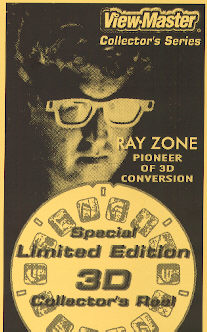 Ray Zone Pioneer of 3-D Conversion
Ray Zone Pioneer of 3-D Conversion
Here is the first View-Master reel made containing images made by Ray Zone, a pioneer of converting 2D images to 3D.
Serious View-Master fans will appreciate this limited edition offering and will want to add it to their collection.
See below for contents of the reel, and more about Ray. Please use 3D glasses to view the images.
Contents
1. Boys Reading 3-D Comics (VM-1)
It was the "World's First" Three-Dimension Comics featuring Mighty Mouse published by St. John in September, 1953 that made a confirmed 3-D nut out of Ray Zone. Ray was 6 years old at the time and looking through the red and green anaglyphic glasses at the 3-D comic page created an impression on Ray that never left him. Here we see a group of young boys in 1953 reading that first 3-D comic. This photograph was originally "flat" until Ray Zone got it and converted it into the 3-D that you see here. And you thought it was a 3-D photograph!
2. 3-DTs (VM-2)
It was comic book artists Joe Kubert and Norman Maurer who first invented 3-D comics for St. John Publishing in 1953. When "Three-Dimension Comics" featuring Mighty Mouse sold a million copies in less than a week (at 25 cents each when most 4-color comics were selling for a dime) the publisher wanted to convert all St. John comics to 3-D in a big hurry. So Joe and Norman hired a bunch of extra artists to convert the flat St. John comics to depth. They all got a case of the "3-DTs" and produced this funny story that appeared in "Whack" 3-D Comics.
3. Coochy Cooty (VM-3)
In 1982, Susan Pinsky hired Ray Zone to write the 3-D Comic "Battle for a Three-Dimensional World" illustrated by the great Jack Kirby. This book was published by 3D Video Corporation and led to a rebirth of 3-D comic books. Ray Zone then started his company "3-D Zone" to convert flat art to 3-D for all kinds of applications from 3-D advertisements and posters, to 3-D T-shirts and comic books. Here is a cartoon by underground comix great Robert Williams converted to 3-D by Ray. It depicts Williams' underground cartoon character Coochy Cooty adrift in the 3-D excitement of the "Ray Zone."
4. VarBiz (VM-4)
The first business magazine to be published entirely in 3-D was VARBusiness magazine in April 1989. Every editorial page of this trade publication as well as the cover was in 3-D produced by Ray Zone and there were also 22 pages of 3-D ads. The 3-D cover featured a groovy cartoon by Lou Brooks which depicted a crazed golfer with his eyes popping out through 3-D glasses. Ray Zone shares this zany fellow's excitement over 3-D. This is actually Ray Zone's alter ego! The cover won an "Ozzie" Gold Award of Excellence for Best Trade Cover in 1989.
5. Bugs (VM-5)
Since 1983 Ray Zone has converted several hundred advertisements and brochures to 3-D. He has also produced 3-D conversions for 3-D underwear, 3-D coloring books, 3-D high school yearbooks and even a 3-D mural in Hollywood. These cross-sections of soil beneath baby corn plants show a variety of insects that will destroy corn before it gets a chance to thrive. This image was produced in 3-D by Ray for a direct mail piece to farmers for the American Cyanamid company which wanted to sell a new pesticide and demonstrate the kind of bugs it would kill. Can't you just see the farmers putting on the red/blue anaglyph glasses to look at this?
6. Krazy Thinker (VM-6)
In 1987 Ray Zone started publishing 3-D comics through his company the 3-D Zone. His goal was to convert some of the classic comic strips to 3-D and here we see the famous creator of "Krazy Kat," George Herriman, in a cartoon self-portrait surrounded by his creations. In addition to Krazy Kat we also see Ignatz the Mouse atop Herriman's hat and Offissa Pupp. It's a big job to produce a daily comic strip and the cartoonist looks like he's stumped! It's alright, though, because he produced another decade of work after drawing this self-portrait.
7. I Love 3-D (VM-7)
Many cartoonists have caricatured Ray Zone and his mania for 3-D. One of the wildest was done by Jim Engels for the 3-D Zone comic book "3-Dementia Comics" in 1987. "3-Dementia Comics" was an entire book featuring humorous stories about 3-D. To convert this image to 3-D Ray decided to create maximum depth and as many levels as he could fit into the image using his "cut-and-shift parallax adjustment" method. This was a time-consuming process where it was necessary to physically cut out each level with an exacto-blade knife.
Ray '3-D' Zone
Ray Zone has produced or published the separations for over 130 3-D comic books featuring such well-known characters as Batman, Superman, Green Lantern, Flash Gordon, Donald Duck, Roger Rabbit and The Simpsons. Since 1983 he has created 3-D conversions, 3-D glasses and 3-D printing for many unusual applications for a variety of clients such as Walt Disney Company, Warner Brothers, Saban Entertainment, Cheerios, McDonalds, American Express and many others. Through his company, 3-D Zone, Ray has also produced 3-D video and computer applications as well as autostereoscopic lenticular point-of-purchase displays. Ray Zone presents 3-D slide shows at public libraries, trade shows and museums on the history of 3-D and 3-D art. He writes numerous articles on the history of 3-D for a variety of publications including Stereo World, Stereoscopy, 3-D News, Inside 3-D and American Cinematographer magazine. Ray is a member of the Stereo Club of Southern California, the National Stereoscopic Association, The Stereoscopic Society, the International Stereoscopic Union and the Third Dimension Society. He is a 1985 winner of the "American Comic Book Awards" for Special Achievement in the Field of 3-D Comics and the "Inkpot Award" in 1987 for Outstanding Achievement in Comic Arts. For a unique look at 3-D comics and the history of 3-D visit Ray's website at:
http://www.ray3dzone.com/.
How Does He Do That? Ray Zone Explains 3-D Conversion
I can't tell you how many times I have been asked how to make a 3-D conversion. Recently, in response to this query, I attempted to boil the whole 3-D conversion process down to a nutshell with a series of simple steps. My answer pertained specifically to 3-D comics, printed with red/blue anaglyphic inks, but the process is essentially the same whether you are creating stereo conversions for Viewmasters, 3-D slide shows or 3-D comics. Here are the steps:
- 1. Start with two identical pictures
- 2. Take one of the pictures. Cut out what you want to be in the background. Move it slightly to the left and paste down.
- 3. Cut out what you want to be in the middle. Don't move it. Paste down.
- 4. Cut out what you want to pop out in foreground. Move it slightly to the right and paste down.
- 5. This will be the left eye picture.
- 6. The picture you haven't changed will be the right eye picture.
- 7. Make one picture red and the other picture blue.
- 8. Look at with 3D glasses.
With this description, the 3-D image will have 3 levels of depth. And each shift of the image will create "holes" in the picture that will need to be filled in with the appropriate art which we would see if the background images were extended or continued behind the objects moving into the foreground. The 3-D conversion artist must produce a left and right eye image from the single, "flat" monocular image. By cutting out background, middle ground and foreground elements and moving them left or right, the 3-D artist is putting the same kind of differences into the images that our two eyes see when looking at the world from two slightly different, horizontally displaced, points of view.
For additional levels, the horizontal shift is varied slightly, creating more holes in the image that require "detailing" when all the shifting of the cut-out elements is completed. I produced over 100 3-D comics by actually cutting apart a copy of the art with an exacto-blade and pasting it back together for the second eye view. Since 1995, I have used a computer to cut-apart and reassemble the art. Detailing of the reassembled image is streamlined with the computer and you can also use some other functions to distort and "stretch" the image for more realistic 3-D. The very first image on this reel of the "Boys Reading 3-D Comics" was converted to stereo with the computer. All the rest of the images were converted by physically cutting apart the artwork with an exacto-blade. That's a lot of work. Imagine how much cutting, pasting and detailing is necessary if you are going to make a 3-D image with twenty or more levels of depth!
Ray Zone Viewmaster Reel
Ray Zone Viewmaster Reel
No se pudo cargar la disponibilidad de retiro
Share
SKU:SKU: 669
Ver todos los detalles

